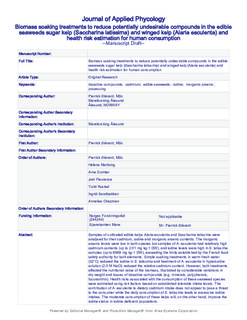| dc.contributor.author | Stévant, Pierrick Francois Denis | |
| dc.contributor.author | Marfaing, Hélène | |
| dc.contributor.author | Duinker, Arne | |
| dc.contributor.author | Fleurence, Joël | |
| dc.contributor.author | Rustad, Turid | |
| dc.contributor.author | Sandbakken, Ingrid | |
| dc.contributor.author | Chapman, Annelise Sabine | |
| dc.date.accessioned | 2018-04-13T08:25:22Z | |
| dc.date.available | 2018-04-13T08:25:22Z | |
| dc.date.created | 2017-11-22T10:25:02Z | |
| dc.date.issued | 2017 | |
| dc.identifier.citation | Journal of Applied Phycology. 2017, Published ahead of print 1-14. | nb_NO |
| dc.identifier.issn | 0921-8971 | |
| dc.identifier.uri | http://hdl.handle.net/11250/2494005 | |
| dc.description.abstract | Samples of cultivated edible kelps Alaria esculenta and Saccharina latissima were analysed for their cadmium, iodine and inorganic arsenic contents. The inorganic arsenic levels were low in both species but samples of A. esculenta had relatively high cadmium contents (up to 2.01 mg kg−1 dry weight (DW)), and iodine levels were high in S. latissima samples (up to 6568 mg kg−1 DW), exceeding the limits established by the French food safety authority for both elements. Simple soaking treatments in warm fresh water (32 °C) reduced the iodine in S. latissima and treatment of A. esculenta in hypersaline solution (2.0 M NaCl) reduced the relative cadmium content. However, both treatments affected the nutrient content of the biomass, illustrated by considerable variations in DW and the content of bioactive compounds (e.g. minerals, polyphenols, fucoxanthin). Health risks associated with the consumption of these seaweed species were estimated using risk factors based on established tolerable intake levels. The contribution of A. esculenta to dietary cadmium intake does not appear to pose a threat to the consumer while the daily consumption of S. latissima leads to excessive iodine intakes. The moderate consumption of these kelps will, on the other hand, improve the iodine status in iodine-deficient populations. | nb_NO |
| dc.language.iso | eng | nb_NO |
| dc.publisher | Springer Verlag | nb_NO |
| dc.title | Biomass soaking treatments to reduce potentially undesirable compounds in the edible seaweeds sugar kelp (Saccharina latissima) and winged kelp (Alaria esculenta) and health risk estimation for human consumption | nb_NO |
| dc.type | Journal article | nb_NO |
| dc.type | Peer reviewed | nb_NO |
| dc.description.version | acceptedVersion | nb_NO |
| dc.source.pagenumber | 1-14 | nb_NO |
| dc.source.volume | Published ahead of print | nb_NO |
| dc.source.journal | Journal of Applied Phycology | nb_NO |
| dc.identifier.doi | 10.1007/s10811-017-1343-8 | |
| dc.identifier.cristin | 1517087 | |
| dc.relation.project | Norges forskningsråd: 244244 | nb_NO |
| dc.description.localcode | This is a post-peer-review, pre-copyedit version of an article published in [Journal of Applied Phycology] Locked until 21.11.2018 due to copyright restrictions. The final authenticated version is available online at: https://link.springer.com/article/10.1007%2Fs10811-017-1343-8 | nb_NO |
| cristin.unitcode | 194,66,15,0 | |
| cristin.unitname | Institutt for bioteknologi og matvitenskap | |
| cristin.ispublished | true | |
| cristin.fulltext | postprint | |
| cristin.qualitycode | 1 | |
